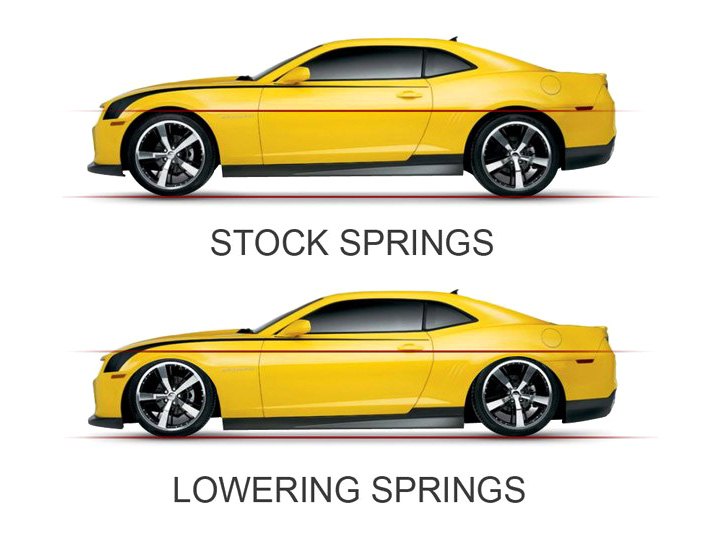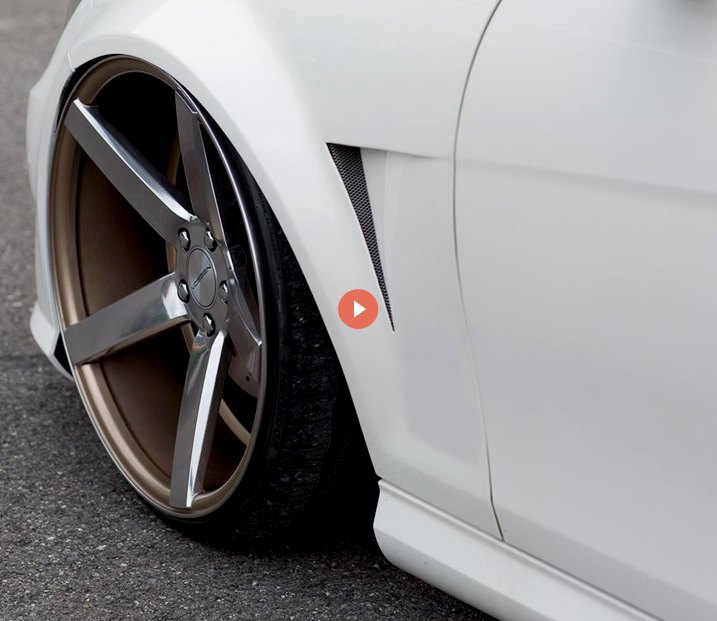
Lowering is high on the list of many people who want to improve the appearance of their car. Let's face it, bringing down those fenders so they're closer to the upgraded wheels makes the car look much better. Getting rid of that ugly stock ride height gap between the fenders and tires is what makes your run of the mill daily driver into a sport tuner. But just how do you go about lowering a car? There are a few options, so read on to find the one that's right for you.
We all have to deal with a budget when we're working on our cars, but the suspension is one area where you shouldn't skimp. You won't find info on cutting springs or putting clamps on the stock springs to lower the car in this article. Those methods may be inexpensive, but they can also cause bodily injury or damage to the car. If you want to lower your car with the coil springs, then replacing them with lowering springs is the way to go. The coils on lowering springs are closer together than the factory springs and this will give you the drop you seek. In general, you want to look for lowering springs with a higher or stiffer spring rate to keep the car from bottoming out or having a rough or bouncy ride. Once you've found the correct lowering kit and the correct spring rate you're in business.
Spring Rate
But what is spring rate, anyway? The spring rate is how much weight in pounds it will take for one coil to compress or squeeze by one inch. For example, if you have a progressive spring rate that is 5 lbs. to 20 lbs., it will take 5 lbs. to compress the spring the first inch, and then 6.5 lbs. for the second inch and so on until the last inch of travel, which will take 20 lbs. to compress.
Continuing with this example, if you lower a vehicle 1 inch you'll want to make sure the spring rate is at least 1.5 times greater than the original rate to keep the vehicle from bottoming out. This will be equal to a progressive spring rate of about 7.5 lbs. to 30 lbs., hypothetically speaking of course; spring rates will vary from vehicle to vehicle. To determine the proper spring rate for your car it will depend on how much you are lowering the car and the stock spring rate. If the spring rate is not higher on a lowered vehicle, then bottoming out will become unavoidable. You should definitely get the spring rate right if you drive on city streets that contain a lot of potholes.
Coil-Over Shocks
But what if you want to lower your car and also make it handle better? If that's your goal then consider coil-over shocks. Coil-over shocks replace the original springs and shock absorbers. With coil-overs, not only is the ride height adjustable but you can also change the stiffness of the shocks. In some cases you can adjust the stiffness to suit your driving conditions. For example, if you use your car on track days you can stiffen the shocks so there is less travel around corners, and then you can soften the suspension to make the car ride more comfortably on regular streets.
Lowering your vehicle and stiffening the shocks with coil-overs helps with body lean and keeps the weight transfer to a minimum to help with handling. Aerodynamics improves at higher speeds as well. By lowering the vehicle, the drag coefficient is reduced, which means you can cut through the air with less effort! Coil-over springs and shocks are designed to work in unison and they're developed to work better with a lowered suspension height. They provide the sporty feeling and aggressive stance that will turn heads and make everyone want to borrow your car. This is the most popular way to lower a car and the good thing is most kits out there start off at the same price as replacement shocks and springs!
Airbag System
Finally, airbags are another option that is becoming more popular with going low. The airbag system (not to be mistaken with the safety devices in your interior!) is similar to the hydraulics you see in low riders in the way the car can be lowered and raised. However, unlike the hydraulic system that uses compressed oil or fluid, the air bag system uses compressed air to fill a bag to raise the vehicle, and a valve system that deflates the bag when you want to go low. You can also drop the back, front or sides and have a crazy look when rolling down the street. The biggest plus with an air bag system is you can have the vehicle sit at stock ride height during normal driving conditions. Air bag systems are available in universal kits where modification to the vehicle is necessary, and model specific kits that are custom tailored to the vehicle.

Universal airbag kits are a complete custom installation. Modifications to the factory shocks are needed to make the airbags fit. These kits are mostly comprised of the air bags, air compressor, air valves, switch box, airline, fittings and a pressure switch. The system works to keep the bags inflated to the programmed pressure. If you want to inflate the airbags, just hit the button and the compressor will pressurize and fill them to the desired pressure. When lowering is desired, the system uses the valves to deflate the airbags. When you want to go low, just hit the button to release the pressure in the bags and the valve system will release to the proper pressure for the correct height adjustment. The system works simply and is user friendly. The second type of kit is the model specific kit. No modifications to the vehicle are necessary, just replace the factory shocks and wire up the tank and associated parts and you're done. This system works in the same way as the universal airbag kits that require modification. The main difference is the price range. While most universal airbag kits will run $800 to $1100, the model specific setups start at $1800 and go up from there. In the end the outcome will be the same: a fresh ride with a great stance and you will surely be at the top when riding low!


